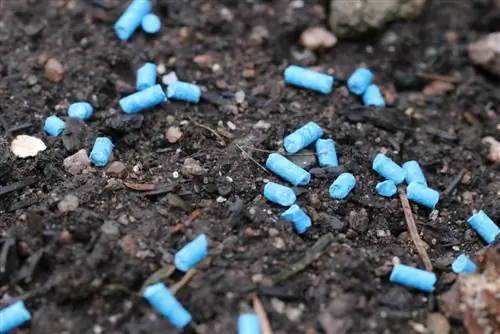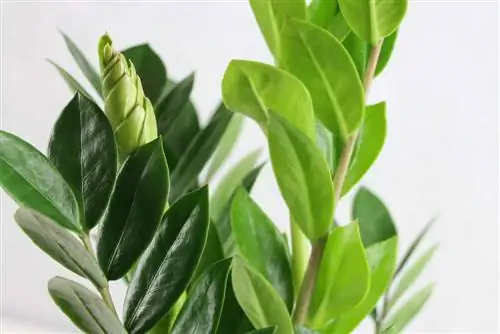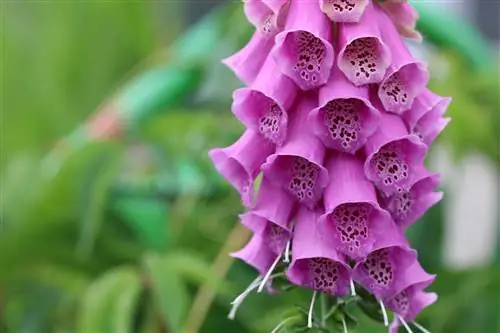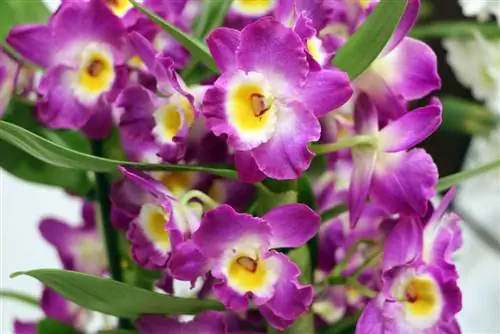- Author admin [email protected].
- Public 2023-12-17 03:39.
- Last modified 2025-01-24 12:45.
Snails have to go! All gardeners, without exception, agree on this. They stick to our plants, especially in rainy years. Once they're on, they won't let go until there's not much of the green left. Small blue slug pellets promise quick relief. When spread out, they lure the unsuspecting snails to their doom. Who else are the grains poisonous for?
What is slug pellets?
Small poison bait is called slug pellets. They are pressed into grain form and are used as a control agent against snails. This is a so-called molluscicide. The use and form have led to the harmless-sounding name slug pellets.
- the grains are bright blue to greenish
- they are scattered in the garden
- Snails are attracted by the scents they contain
- they eat the grain and quickly die from it
- some slug pellets work on contact
- Snails absorb the toxin through their mucous membrane
- they usually die immediately on the spot
- dead snails must be picked up or covered with soil
- some snail pellets only kill the snails after days
- they can retreat to their shelters beforehand
- should not pose a danger to other animals
Note:
Snail pellets are poisonous to all species of snails, regardless of whether they belong to the harmful or harmless snail species.
Poisonous substances in snail pellets
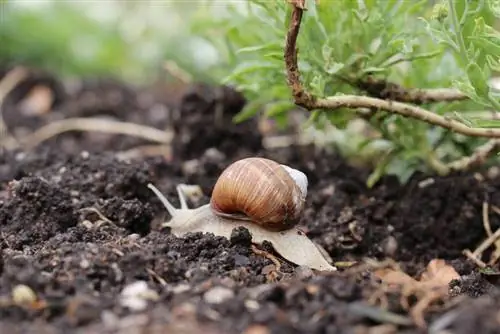
Various preparations for snail control are available commercially. The composition of these control agents differs from each other. Alkaloids, s alts, hormonal active ingredients and combinations of these substances are common. If used improperly, the toxins pollute the groundwater. If metaldehyde is contained in the snail pellets, special caution is required. Ingestion of this poison can result in death for children and mammals.
The active ingredient methiocarb, previously used in slug pellets, is deadly to humans and pets. It has not been allowed in Germany since the end of 2014. However, any remaining stocks that may still be present can pose a great danger. These must be disposed of properly.
Iron (III) phosphate is touted as an alternative active ingredient and is even approved for organic cultivation. The snails ingest the grain orally and starve to death after a few days. The reason is that this slug pellet closes their throat and prevents them from eating. However, they can continue to lay eggs until they die. Skin contact with iron (III) phosphate is not harmless. Hands must be washed thoroughly afterwards.
Who is slug pellets poisonous to?
Snail poisons are poisonous to snails, but they also pose a danger to other animals. If poisoned snails are left lying around, they can be eaten by their natural predators. This poisons them themselves. Affected are:
- Birds
- Frogs
- Toads
- Beetle
- Hedgehog
- Shrews and other animals
Of course, the snail pellets also have an effect on species of snails that are not harmful, even those that are protected, such as the Roman snail. Slug pellets can be life-threatening and not just for wild animals. Snail pellets often contain strong poisons, the ingestion of which can have fatal effects on pets. Cats, dogs, rabbits and other mammals are often exposed to this danger because they stay in the owner's habitat and can usually move freely.
But these poisons are by no means harmless to humans either. They are particularly dangerous for babies and small children. A few grams of metaldehyde is fatal even to an adult. But while adults are aware of the danger and can avoid it, the small, blue grains are attractive to children and pets.
Precautions when using slug pellets
For most problems in the home or garden, we have various control products available, many of which are not poisonous. With so many alternatives, there is no need to endanger the lives of people and animals. If you still want to use slug pellets for some reason, choose the version with ferric phosphate, which is the least toxic. Always follow precautionary measures.
- only use slug pellets in exceptional cases
- sprinkle only as little slug pellets as necessary
- use gloves
- keep children and pets away
- educate other garden users about the toxicity
- keep the slug pellets out of reach
NOTE:
The most important precautionary measure to effectively avoid poisoning is: Keep your hands away from toxic substances, without exception!
Snail pellets are interesting for small children

Small children are curious and quickly put everything in their mouths, especially when they feel unwatched by adults. A few of the small blue snail pellets are enough to cause serious symptoms of poisoning in the child. Always store slug pellets so that children cannot get their hands on them.
However, remember that if the grain is scattered in the garden, it can be discovered by children and ingested unnoticed. They will neither be able to keep your child out of the garden for long, nor do you have a guarantee that all the slug pellets will be eaten away after a certain period of time. Even after days, slug pellets can be lying around and pose a significant risk to children.
Note:
Slug pellets are also poisonous to adults. However, the danger is lower because they would hardly eat the slug pellets intentionally.
Symptoms of poisoning in children
If a child has consumed slug pellets, severe symptoms of poisoning will appear within a few hours. However, if you have observed the use or otherwise become aware of it, you should not wait until the first symptoms appear. If you did not notice that you had ingested the poison, the following symptoms of poisoning can be seen as a clear warning sign:
- increased salivation
- Daziness
- Nausea and even vomiting
First measures in case of poisoning of children
Parents or other caregivers should call emergency services immediately if poisoning by slug pellets is suspected. But even if the source of the poisoning is not yet known, action must be taken quickly if symptoms like this occur. Any home remedies are out of place here and can even do harm if you don't know the true situation. Get the child to spit out any leftovers. Since some poisons can damage your he alth very quickly and irreparably and even be fatal, valuable time should not be wasted. Support the treating doctor by making the diagnosis easier:
- state immediately when you call which poisoning you suspect
- Take some of the vomit with you to the doctor
- take the toxicant packaging or label with you
Slug pellets and pets
On the packaging of the snail pellets, the warnings that indicate the danger to pets are usually printed in very small print. Some preparations even say that they are safe for pets. For these reasons, many pet owners use slug pellets against snails without hesitation. But slug pellets that contain metaldehyde can quickly become a danger to pets.
- Dogs are magically attracted to slug pellets
- especially small, curious dogs could eat it quickly
- the grain is also dangerous for a cat
- Toxins get stuck on the paws
- When you lick your paws, the toxic substances get into your body
- other pets such as rabbits also react to the poison
It's not just the scattered grain that's a temptation, open packages that are easily accessible can also become a deadly trap for pets. Then there is a particularly high risk of ingesting a high dose of poison within a short period of time. By the time the first symptoms appear and the person notices that they have ingested the poison, it may already be too late.
Symptoms in pets
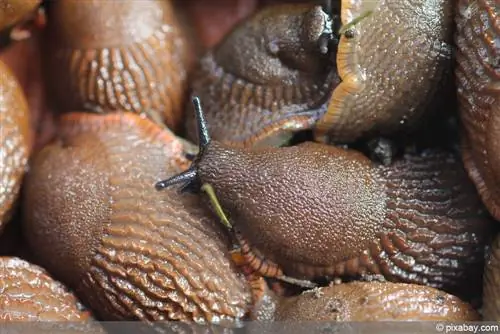
The latency period until the poison takes effect is short with metaldehyde. Acute symptoms of poisoning occur approximately 1-3 hours after ingesting the poison. These can vary in severity depending on the amount of poison that has entered the bloodstream.
- viscous salivation, panting
- Vomiting and/or diarrhea
- Muscle tremors
- Heart racing
- Coordination disorders
- frequent seizures and even coma
- Fever reaches critical values above 41 degrees Celsius
- high fever destroys body proteins and cells
Note:
The vomit and feces have a bluish-green color. This is a clear sign that there is slug poisoning.
Measures when poisoning pets
There is no antidote for metaldehyde. If you catch your pet eating slug pellets or observe the symptoms of poisoning listed, you should consult a veterinarian as soon as possible. There is nothing you can do to alleviate the consequences of poisoning other than to stop the animal from continuing to consume the grains. The vet has to make the animal vomit so that as few toxins as possible get into its bloodstream and have a bad effect.
Medicines to bind the toxins, intestinal irrigation and an artificial coma could also be necessary. All of this makes the rescue operation a costly affair that, unfortunately, is often unsuccessful. If the animal's life can be saved, long-term consequences cannot be ruled out. In particular, the poison could have caused significant and permanent damage to the liver.
Tip:
If the animal has vomited at home, take some with you to the doctor. An analysis could provide valuable information about the poisoning, especially if the type of poisoning is still unclear.

